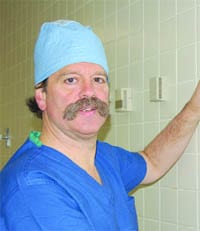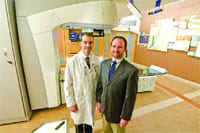Joint Decisions Orthopedic Surgeon Dr. Leonard Wagner Gets Patients Moving Again
Dr. Leonard Wagner recalled a patient who needed both knees replaced, and had been taken care of by her youngest daughter for some time.
“She was wheelchair-bound and couldn’t walk, because she was constantly in pain,” he said. “She needed to have new knees. We did the first one, and that afternoon, she asked when she could schedule the second knee, because she already had less pain than she had experienced in a long time — and this was the day of surgery!”
About a month later, she had the second knee replaced and became independent of any walking aid save a cane. Her caretaker daughter won a little independence, too, and got married soon after — with mom effortlessly walking her down the aisle.
“In the old days,” said Wagner, an orthopedic surgeon at Mercy Medical Center, “people couldn’t walk with certain conditions; they were wheelchair-bound. Today, we can replace a joint, whether it’s a hip or a knee, and they love you — because the pain is gone, and they can walk.”
This constant reminder — that successful surgery leads, in many cases, to a happier, more fulfilling life — gives Wagner plenty of job satisfaction. And technology, he said, is continually leading to even less invasive, more effective procedures than the ones routinely practiced today.
Being Hip
Take, for example, a gender-specific knee-replacement implant for women, the Zimmer Gender Solutions NexGen High-flex Implant. The device features a slightly different shape and smaller design to better accommodate a woman’s anatomy, allowing for better function and durability.
“It turns out that men have a slightly different anatomy when we’re talking about knees,” Wagner said. “This product takes into account that difference and fits a little better. It’s better-contoured, resulting in a more satisfactory result.”
Specifically, he said, women with the Zimmer implant should find it easier to bend, flex, and squat without pain. Men continue to receive what used to be a unisex implant, but one that has been modified to allow easier bending and flexion as well.
“By the time a patient comes in for this type of surgery, they have often suffered with severe knee pain for some time,” Wagner said, and don’t want to suffer more. The gender-specialized implant, he explained, makes it less likely that surgeons will have to perform intra-operative adjustments during surgery, meaning fewer complications later on. “Clearly, this is a breakthrough for women in need of knee-replacement surgery, and the outcomes speak for themselves.”
Not only do such breakthroughs give patients more mobility than similar procedures did 20 years ago, but recovery times have been significantly reduced by a greater emphasis on laparoscopy, or minimally invasive surgery performed with the help of tiny cameras.
“Knees are done now with smaller incisions and less dissection, so that the recovery time is potentially quicker,” he added. “I have patients go home 24 hours after a total knee arthroscopy. Most people go home the second day after surgery.”
That’s a great benefit for the Baby Boomer generation, which tends to be more physically active than previous generations approaching their 60s and 70s, an age when many joint replacements are conducted.
“They usually tend to be older people who are still active, and they have arthritis in the knee that becomes a painful, limiting factor in their activities during the day,” said Wagner. After trying other treatments, “many people reach the point where the situation is impacting their daily life, and they’re fairly miserable; they just want to get rid of the pain and do basic things — like walk.”
At the other end of the spectrum, sports injuries such as ACL tears that were typically career-enders in the past might keep athletes out only until the next season — or sooner. “I get to treat the whole spectrum, from high schools to octogenarians, and often we see them return to full mobility, whether they suffered a sports injury, an accident, or just the wear and tear of getting older.”
Get a Move On
The satisfaction of seeing such results is one of the benefits of what can be challenging work. “Patients are so appreciative,” he said. “Go back a generation, and people went right to a wheelchair. I’ve sat with patients who didn’t go to family functions anymore because it hurt too much to walk.” Those stories, he said, are becoming more rare.
“The thing about orthopedics is, you can have a tremendous impact on a patient’s quality of life and level of functioning,” Wagner said. “You can put together a fracture, or a dislocation of the ankle, and return someone to full activity by operating on them, instead of throwing them into a cast and having arthritic ankles in their 20s.”
When he’s not helping patients stay active, Wagner, a photography enthusiast, can sometimes be seen with his camera, shooting some activity or other — such as one of his son’s ski runs captured with a dynamic crispness and hanging framed in his office.
“I take a lot of pictures,” he said, adding that his wife occasionally wonders why he keeps going after landing a good shot. “It’s all about looking for that ultimate picture — and then, when you find it, you’re looking for the next one.”
Sounds like someone who appreciates what it means to keep moving.



